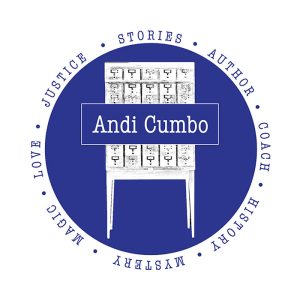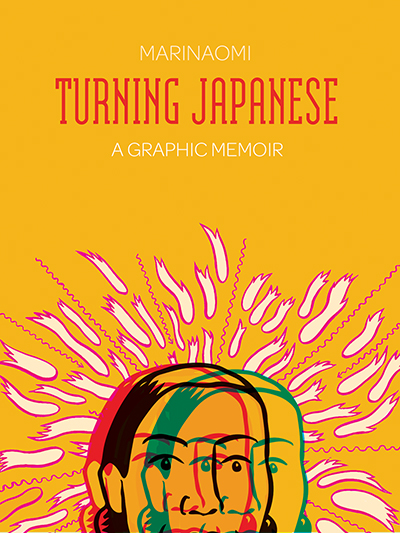I’m woefully lacking in my knowledge of graphic novels/memoirs, but MariNaomi may help change that. I love her pet projects for Cartoonists of Color and LGBTQ cartoonists, and her wisdom about working with friends is something I might just have to try. You’ll want to sit with this one a while, folks.
Turning Japanese is a graphic/comics memoir about when, in my early twenties, I decided I wanted to connect with my Japanese side. I grew up in a primarily Caucasian town and knew very few Japanese Americans. I also never learned the language, so I decided that I’d try to do so by working at a hostess bar, which is a job where the hostesses pour drinks and make conversation with the clients. Then the plan was to travel to Japan and speak with my relatives for the first time without my mother translating for me. The idea was that I’d develop a deeper relationship with my grandparents, and that they’d get to know the real me, not the version of me that my mom sold them. So I basically did a lot of that, but things didn’t really go as I’d planned.
2. What stories, themes, motivations do you find yourself drawn to in your work and in the works you read?
As a reader, I’m drawn to stories that show me something I’ve never seen before, but in a relatable way. This means the writer must draw me in by targeting my empathy and compassion before they hit me with something unfamiliar. As a writer and artist, this is also what I strive to do. It’s pretty tough, since every reader comes to the table with different backgrounds and experiences. Who knows what each person will relate to?
3. What do you do when you’re not writing/drawing?
When I’m not writing/drawing, I spend time answering emails, scheduling and performing readings, and working on my pet projects: The Cartoonists of Color database and the LGBTQ Cartoonists database. I created these to help promote marginalized comics creators, which so far has been going pretty well. When I started Cartoonists of Color last year, for example, I had just over a hundred creators in it. Now there are almost nine hundred!
My non-work activities mostly involve hanging out with friends and/or my husband and our menagerie (four cats and two dogs). In fact, I have a cat on either side of me (a kitten on my lap, the eldest snuggled against my butt) as I type this.
4. What made you believe you could write a book? How did you dispel doubt as you wrote?
I’ve wanted to write books pretty much my whole life, so doubt was never part of the creative process. The doubt usually comes after the book is done but before it’s released into the world. I attempt to ignore it by diving into my next project.
5. Describe the first 2-3 steps of your process in writing your book.
My process changes with each book. Currently, I write as much down as possible, then spend the next year or five paring that down. A lot of editing happens when I’m penciling and inking the art. Once something’s on the page, it becomes so much clearer what’s important to the story and what isn’t.
6. How do you balance what will sell with what you want to say?
What’s marketable at any given time fluctuates, and frankly, the creation of a graphic book is so time-consuming that if I were to work towards the market at any given point, by the time I’m done with the book, the market will have changed.
My main focus is on creating something genuine, and then I hope for the best. My book Kiss & Tell took eight years to make, and by the time I found a publisher, graphic memoirs about young women just happened to be in fashion. I believe that was maybe a year-long fad that I managed to jump on at its tail end. Lucky me!
Hopefully, going forward, I’ll be able to play a part in creating these trends, since there’s really no way for me to ride them.
7. What is your least favorite part about being a writer?
Having to self-promote is the worst! Nobody likes begging for attention or feeling like a pest.
8. What are a few of your favorite books of all time?
There are books that inspired me as a youth, and books that inspire me now, and they’re very different. Such as, I loved the Hitchhiker’s Guide to the Galaxy when I was young, but the last time I read it, it didn’t hold up. Same for all the Anne Rice vampire novels and Stephen King’s horror collections. They inspired and delighted me at the time, and I remember them fondly. But I’m just not in the same space anymore. My literary needs are different.
Some books that have held up are certain Kurt Vonnegut, Jr., books (Slapstick was a book that changed me, chemically, and I still love it very much), Darcey Steinke’s Suicide Blond, and Armistead Maupin’s Tales of the City series. More recent favorites include Cheryl Strayed’s Tiny Beautiful Things, Phoebe Gloeckner’s Diary of a Teenage Girl, Roz Chast’s Can’t We Talk About Something More Pleasant? and Carol Tyler’s You’ll Never Know trilogy. I wrote out a very long list of inspiring books here.
9. How did you learn to write?
I dropped out of high school and only briefly went to a community college, so formal education was never my thing. I don’t like being told how to learn, but I love learning! From the moment I quit school, I spent a lot of time reading all kinds of books, examining art, and practicing my craft.
10. What are some things that get in the way of your writing? How do you move them out of the way?
Dirty dishes, needy cats and dogs, a checkbook that needs balancing, floors that need sweeping, litter boxes that need cleaning, social media, an alarming inbox, and on and on.
I recently quit Facebook, and that helped a lot. I also sometimes invite artist and writer friends over for work days, and despite the fact that we often chat and catch up at first, we get a surprising amount of work done. I think it has to do with keeping each other in check. When I have people over, I’m far less likely to stare at my phone the way that I do when I’m alone.
11. What’s the best writing advice you ever received?
Recently I was struggling with an image I was working on. I asked my friend Yumi what message it was relaying, and she asked me, “What are you trying to say?” It was such an obvious question, but something that hadn’t occurred to me, as if the work had a life of its own and I was just a conduit for a message from the ether. Ever since she said that, I think of that question every time I get stuck.
12. What’s your philosophy and practice about reading reviews of your work?
I read them all obsessively. This has of course caused me grief in the past, but the joy it has brought far outweighs anything negative. My goal of creation is to connect with other human beings, so if I read a Goodreads review where a person connected with my work, it’s all good. And if they didn’t? Well, you can’t please everybody.
 MariNaomi is the author and illustrator of the SPACE prize-winning graphic memoir Kiss & Tell: A Romantic Resume, Ages 0 to 22 (Harper Perennial), the Eisner-nominated Dragon’s Breath and Other True Stories (Uncivilized Books/2dcloud) and the upcoming Turning Japanese (2dcloud). Her work on the Rumpus won a SPACE prize and an honorable mention in Houghton Mifflin’s Best American Comics 2013. Mari also created and maintains the Cartoonists of Color and LGBTQ Comics databases. Visit her website at marinaomi.com or follow her on Twitter @marinaomi.
MariNaomi is the author and illustrator of the SPACE prize-winning graphic memoir Kiss & Tell: A Romantic Resume, Ages 0 to 22 (Harper Perennial), the Eisner-nominated Dragon’s Breath and Other True Stories (Uncivilized Books/2dcloud) and the upcoming Turning Japanese (2dcloud). Her work on the Rumpus won a SPACE prize and an honorable mention in Houghton Mifflin’s Best American Comics 2013. Mari also created and maintains the Cartoonists of Color and LGBTQ Comics databases. Visit her website at marinaomi.com or follow her on Twitter @marinaomi.


